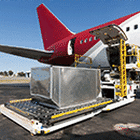
Social distancing and stricter rules aimed at preventing the further spread of coronavirus are reducing the efficiency of air cargo handling, adding time into supply chains and in effect limiting overall available capacity, according to leading forwarders.
The upshot is that the slew of passenger planes now being deployed as cargo-only options are having little impact in terms of lowering freight rates.
As reported by Lloyd’s Loading List, both charter and air cargo freight rates have been spiralling in recent weeks on soaring global demand for medical supplies, pharmaceuticals and perishables and the grounding of passenger fleets.
Rates spike
Over the last week, rates from China to Europe have reached new heights, threatening to price more shippers out of the market and towards alternative sea-air or rail services. The rates surge was led by the Shanghai (PVG) to Europe lane which rocketed 42.33% in a week to reach $7.33 per kg on 6 April.
Forwarders in Asia tell Lloyd’s Loading List that rates out of many Asian hubs including Hong Kong have been routinely higher than $7 per kg over the last two weeks, pushing far beyond even $9 per kg.
The latest price rises come even though airlines have been adding cargo-only passenger bellyhold capacity as quickly as possible.
Long loading times
One leading forwarder said “long loading times of up to 10 hrs” are being recorded while another, based in Asia, said crewing problems due to quarantine restrictions were also “adding time in”.
“Some shippers will wait as long as they have to, and pay whatever is asked,” he added.
Both executives said the use of passenger planes had added to loading times and delays given the extra handling time required to strap cargo to seats.
Neel Jones Shah, global head of air freight at Flexport, said slower handling times were offsetting capacity gains.
“One of the biggest impacts (of coronavirus) we’re seeing is in the ground handling industry,” he said.
“It’s taking much longer to tender and recover freight because many ground handling agents and airlines are short staffed as workers abide by shelter-in-place orders.
“It’s worth emphasizing we’re seeing these delays in aviation, which is considered an essential industry. I expect this to get worse over the next 30 days as the virus spreads and peaks in the US and EU.”
Handling challenges
Brian Bourke, chief growth officer at Chicago-based SEKO Logistics, said the handling challenges in air cargo supply chains at present were many and varied.
“We are dealing with a global pandemic so we are dealing with absenteeism, we are dealing with the health and safety requirements of frontline workers – there are multiple elements creating more friction,” he added.
Paul Tsui, managing director of forwarding and logistics operator Janel Group, said that with air space currently “extremely tight” out of China and Hong Kong, costs spiralling and lead times increasing, some shippers were reverting to ocean options or holding cargo and awaiting further instructions.
“Some buyers are starting to hesitate to ship merchandise by air, or are even holding current orders (and watching) the overall consumer market situation,” he said. “No one is buying much except daily products and medical items such as masks, protective clothes, etc.”
With cargo building up in hubs such as Hong Kong and demand from Europe and the US for non-essential products slowing, warehouse capacity is limited. “Also, public warehouse and private warehouse operations, even for large customers, are only open for limited periods of time with minimum human capacity,” he added.
“This is also affecting the delivery of orders from suppliers selling landed duty paid items.”
Slowing consumer demand from Europe and the US for Asia’s exports will eventually start to impact the air freight market more fundamentally as shippers cut production.
Destination logistics issues
“A lot of importers (in Europe and the U.S.) are starting to re-organize their logistics operation,” said Tsui. “Some of them have even stopped factories overseas shipping until further notice.”
Tsui said eventually the slowdown in overall demand apparent in March would be reflected in falling air freight rates if capacity continues to be added.
“I think that in no more than 2-3 weeks, the market will become very quiet, except for those medical items need for the general public and hospitals,” added Tsui.
“More passenger bellyholds will come to the market very soon from most carriers, depending on their availability of flight crew. To have the aircraft flying in the air is always more economic than grounded.”
Shah agreed, noting that while there are pockets of strong commercial demand, the overall outlook is “rather bleak”, with economists forecasting a dramatic drop in Q2 and possibly Q3 GDP.
He added: “We’re already seeing consignees cancel purchase orders for Q2 and beyond, which is a strong indicator of rapidly decelerating consumer demand.”
Source:lloydsloadinglist
The opinions expressed herein are the author's and not necessarily those of The OLO News.
Quality Companies